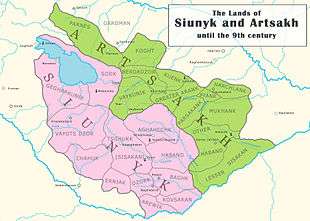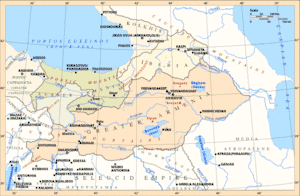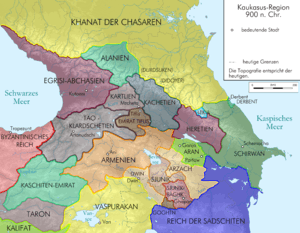Artsakh (historic province)
Artsakh (Armenian: Արցախ, pronounced [ɑɾˈtsʰɑχ]) was the tenth province (nahang) of the Kingdom of Armenia from 189 BC until 387 AD and afterwards a region of the Caucasian Albanian satrapy of Sasanid Persia from 387 to the 7th century. From the 7th to 9th centuries, it fell under Arab control.[1] In 821, it formed the Armenian principality of Khachen and around the year 1000 was proclaimed the Kingdom of Artsakh, one of the last medieval eastern Armenian kingdoms and principalities to maintain its autonomy following the Turkic invasions of the 11th to 14th centuries.[2]
| Artsakh Արցախ | |
|---|---|
| Province of Kingdom of Armenia | |
| 189 BC–387 | |
Location of Artsakh (green) in Armenia | |
| Capital | Parnes |
| Historical era | Antiquity, Middle Ages |
• Established | 189 BC |
• Province of Armenia | 189 BC |
• Part of Persian Empire | 387 |
• Kingdom | 1000 |
• Disestablished | 387 |

Much of historical Artsakh presently overlaps with the region of Nagorno-Karabakh, and is controlled by Artsakh Republic, known as Nagorno-Karabakh Republic until early 2017.
Etymology
According to Armenian and Western specialists, inscriptions dating to the Urartian period mention the region under a variety of names: "Ardakh", "Urdekhe", and "Atakhuni."[3][4][5] In speaking about Armenia in his Geography, the classical historian Strabo refers to an Armenian region which he calls "Orchistene.", which again is believed to be a Greek version of the old name of Artsakh [6]
According to another hypothesis put forth by David M. Lang, the ancient name of Artsakh possibly derives from the name of King Artaxias I of Armenia (190–159 BC), founder of the Artaxiad Dynasty and the kingdom of Greater Armenia.[7]
Others also say that the name comes from Ara the Handsome. Arai Tsakh which translates to Ara's Forest.
Folk etymology holds that the name is derived from "Ar" (Aran) and "tsakh" (woods, garden) (i.e., the gardens of Aran Sisakean, the first nakharar of northeastern Armenia).[8]
The name today is used mostly by Armenians to refer to Nagorno-Karabakh, including areas of land such as Kalbajar that historically had been a part of Artsakh but that the Soviet Union did not permit to be included in the Nagorno-Karabakh Autonomous Oblast of the Azerbaijan SSR.
Geography
Part of a series on the |
|---|
| History of Artsakh |
 |
| Antiquity |
| Middle Ages |
| Early Modern Age |
|
| Modern Age |
Artsakh covered the north-eastern range of the Armenian Plateau[9] and was mostly mountainous and forested.[10] In medieval Armenian sources it is described as a strategic and fortified region.[11][12] It was bordered by the following Armenian principalities: Utik to the east, Gardman to the northeast, and Syunik to the southwest.[13] The river Arax formed the southern boundary. The Kingdom of Artsakh (1000–1261) also included Gardman, Sodk and some other parts of Gegharkunik (in particular the southeastern shore of Lake Sevan).[14] Its area is estimated to have been 11,528 km2.[15]
In the Middle Ages, the neighboring Syunik region (also known as Sisakan, after the town of Sisian) sometimes lent its name to Artsakh, which would sometimes be referred to as "Little Syunik" or "Second Syunik."[16]
Important places (mostly fortified towns) included Parisos, Tigranakert, Sodk, Tsar, Vaykunik, Asteghblur, Goroz and Berdaglukh. The fortress of Tigranakert, which was first excavated in 2005, is believed to have been founded by King Tigranes the Great of Armenia in the 1st century BC, although conceivably it could also have been founded by King Tigranes I (123–55 BC).[17] Later, in the Caucasian Albanian period, the village of Gyutakan (Armenian: Գյուտական, known as the "Royal Village") became of great importance as the residence of Vachagan III the Pious (467–510 AD), the last King of Caucasian Albania. During early medieval times, the castle of Khachen served for a considerable time as the center of Artsakh.
Cantons
According to anonymous 7th century Armenian "Geography" (Ashkharatsoyts) Artsakh comprised 12 cantons (gavars):[18]
- Myus Haband
- Sisakan-i-Kotak
- Vaykunik
- Berdadzor
- Mets Arank
- Mets Kvenk
- Harchlank
- Mukhank
- Piank
- Parzkank
- Sisakan Vostan
- Kust-i-Parnes
- Koght
Status
It is not certain how Artsakh was administered as a sub-national political entity within Armenia. According to some Armenian scholars, Artsakh formed a principality with the adjacent canton of Sodk. Conceivably it was royal land. Its northern part also comprised the principality of Koght and it is possible that the princes of Koght were the original owners of Artsakh.[18] Under the rule of Caucasian Albania, Artsakh, while often referred to, was not a recognized political entity. By the 9th century it comprised a number of small political units, including the principalities of Khachen in the center and Dizak in the south. Only in the 13th century did these two states merge into one – the Kingdom of Artsakh.[2]
Population
Anthropological studies show that the current Artsakh (Karabakh) Armenians are the direct physical descendants of the indigenous population of the region.[19][20] Following the modern consensus among western scholars concerning the origin of the Armenian people, they represent a fusion of the mostly Indo-European natives of the Armenian Plateau (including Artsakh) and the proto-Armenians, conventionally called the "Armens" of Armenian Plateau.[19][20][21][22] According to this theory, from earliest time the Armenian Plateau was inhabited by many ethnic groups. The ethnic character of Artsakh may thus have been originally more diverse than it is now. It may have even been the homeland of the ancient tribes who lived in the region of Arran, although that is not certain.[22][23] It is worth noting that Strabo described Armenia (which then included also Artsakh and Utik) in the 2nd century BC as "monolingual",[6] though this does not necessarily mean that its population consisted exclusively of ethnic Armenians.[24]
According to the Encyclopædia Iranica, the proto-Armenians had settled in Artsakh already by the 7th century BC, though until the 6th–5th centuries BC the Armenians in the strict sense must have lived only on the western half of the Armenian Plateau (in areas between Cappadocia, the Tigris, the Euphrates, and the lake of Van).[25] The proto-Armenians came to Artsakh and adjacent mountainous regions (such as Syunik) somewhat later than the central parts of the Armenian Plateau. They intermarried with the pre-Armenian inhabitants to form the present Armenian people.[21]
By medieval times, from at least the 9th century, the population of Artsakh had a strong Armenian national identity.[23] Its people spoke a local Eastern Armenian dialect, the Artsakhian dialect (today known as the Karabakh dialect), which was mentioned by 7th century grammarian Stepanos Syunetsi in his earliest record of the Armenian dialects[26]
History
Traditional views
According to a traditional Armenian view, based on the accounts of early medieval Armenian historiographers Movses Khorenatsi and Movses Kaghankatvatsi, Artsakh was originally the dominion of a certain Aran who was the progenitor of the House of Aranshahik – "the ancient native Armenian family".[27] Aran was called "the Aghu" (meaning amiable in Armenian)[28] because of his good manners.[29] The genealogy of Aran (old spelling: Eran, hence: Eranshahik) is preserved by the historiographer Movses Kaghankatvatsi, who wrote that Aran belonged to the lineage of the ancient patriarchs and kings of Armenia, including Hayk, Aramaneak, Aramayis, Gegham, Aram, Ara the Beautiful, Haykak, Norayr, Hrant, Perch, Skayordi, Paruyr, Hrachea, Ervand (Orontes) Sakavakeats, Tigranes et al.[27]
Aran was appointed by the King Valarsace of Armenia as the hereditary prince (or nahapet) over the plain of Arran until the fortress of Hnarakert.[30] Aran is also known as the divine eponym[31] and the first governor of the Caucasian Albanians, appointed by Vologases I (Vagharsh I) the Parthian.[27]
Early history
In 1965, Soviet archaeologists discovered the bones of a pre-Homo sapiens human dating back possibly to the Middle Acheulean culture in a cave near the village of Azokh in the province of Hadrut.[32]
Classical Era
In general, archaeological remains in Artsakh reflect the competing influences from around 800 BC of the neighboring rival states of Urartu, Assyria, and Mannai. After the fall of Urartu (6th century BC), most of the region south of the Kura river came under the domination of the Medes followed by the Achaemenian Persians until 331 BC when Alexander the Great invaded the region during his wars with the Achaemenids, upsetting its balance of power.[33] In 189 BC, when the Kingdom of Armenia was re-established by the Artaxiad dynasty, Artsakh became part of the new Armenian state. Strabo reports that King Artaxias I of Armenia (189 BC – 159 BC) expanded his state in all directions at the expense of his neighbors . At this time, he conquered from the lands of Caspiane, before that ruled by the Medes, and "Phaunitis" (supposedly a copyist error for Saunities, i.e. Siwnik), Utik and possibly the unnamed land of Artsakh, lying between Syunik and the Caspian Sea.[2][22] However it is possible that Artsakh had earlier been part of Orontid Armenia in the 4th–2nd centuries BC rather than under Median rule.[2]

Christianity
In 301 Armenia was converted to Christianity under the Arsacid dynasty of Armenia (themselves a branch of the Arsacid dynasty of Parthia. The Armenian historian Agathangelos mentioned the princes of Utik and Sawdk (which probably comprised Artsakh) among the sixteen Armenian princes, who escorted Grigor the Illuminator to Caesarea, where he would be enthroned the High Priest of their land.[34]
Artsakh became a major stronghold for Armenian missionaries to proclaim the Christian Gospel to neighboring countries. In 310 St Grigoris, the grandson of Grigor the Illuminator, was ordained bishop of Caucasian Iberia and Caucasian Albania in the monastery of Amaras, being just 15 years old at the time.[35] After his martyrdom by the Mazkutian king on the field of Vatnean (near Derbent), his disciples conveyed his body back to Artsakh and buried him in Amaras, which had been built by Grigor the Illuminator and Grigoris himself. Hence St Grigoris became a patron saint of Artsakh. The historiographer Pavstos Buzand wrote that "... every year the people of that places and cantons gathers there [in Amaras] for the festive commemoration of his valor".[36]
In the 5th century, Christian culture flourished in Artsakh. Around 410 Mesrop Mashtots opened at Amaras the first Armenian school.[37] Later, more schools were opened in Artsakh.[38]
Armeno-Persian wars
The second half of the 4th century saw a series of wars between the Kingdom of Armenia and Sassanid Persia. After enduring 34 years of warfare, the Armenian nobility of Artsakh and most of other provinces of Armenia revolted, refusing to support the Armenian king Arsaces II (Arshak II) anymore out of war-weariness.[12][39] Following the defeat by the Sassanid and Caucasian Albanian armies, the Armenian strategist (sparapet) Mushegh Mamikonian severely punished the rebelling Armenian provinces, Artsakh included, and subjected them back under the rule of King Arsaces II after he started and won a war against the Sassanids together with Roman assistance. Then in 372 he attacked the Caucasian Albanians and took back from them the neighboring province of Utik, in the process re-establishing the river Kura as the boundary between Armenia and Caucasian Albania.[12]
Medieval Period

However, war between the Persian and Roman archrivals continued, and in 387 AD, according to the peace treaty between the two powers, the Armenian kingdom was partitioned between them. Caucasian Albania, as an ally of the Sassanids at the time, gained all the right bank of the river Kura up to the Araxes, including Artsakh and Utik.[40]

Following the inconclusive Battle of Avarayr (451), in which a united Christian army consisting of Armenians, Georgians, and Caucasian Albanians[41] clashed with the Sassanid army, many of the Armenian nobles retreated to impassable mountains and forests in several provinces, including Artsakh, which became a center for resistance against Sassanid Iran.[42] From the 5th to the 7th centuries AD Artsakh was ruled by the Armenian noble family of Arranshahiks. Furthermore, the Armenian rulers of Artsakh began to play a considerable role in the affairs of Caucasian Albania.[43] In 498 in the settlement named Aghuen (in present-day Mardakert region of Nagorno-Karabakh),[44] an Albanian church assembly was held, in the presence of the nobility and princes ("azgapetk") of Artsakh and the king Vachagan the Pious, to adopt the Constitution of Aghven, which would arrange relations between the nobility (landlords), clergy and village people.[45]
In the 7th–9th centuries, the Southern Caucasus was dominated by the Arabian Caliphate. In the early 9th century two Armenian princes, Sahl Smbatian and Esayi Abu-Muse, revolted against Arab rule and established two independent principalities in Artsakh: Khachen and Dizak. At the time the Byzantine emperor Konstantinos Porphyrogennetos addressed letters "to prince of Khachen – to Armenia", being the residence of the Armenian prince Sahl Smbatian. In 852–855 Sahl-Smbatian and Esayi Abu-Muse fought against Arab commander Bugha.[46] The latter 28 times unsuccessfully attempted to conquer Ktich Castle, the main stronghold of the Armenians of Artsakh. The ruins of Ktich (now Gtich) castle and the church are situated in the province of Hadrut in the modern Nagorno-Karabakh Republic. The House of Khachen continued to rule Artsakh intermittently as vassals until the early 19th century, through the subsequent full domination by the Kara Koyunlu, Ak Koyunlu, Iranian Safavids, Zands, Afsharids, and Qajars, until it was ceded to Imperial Russia following the outcome of the Russo-Persian War (1804-1813) and the following Treaty of Gulistan.[2] It was then often referred to the Land of Khachen (later Karabakh).
External links
Notes
- Hewsen, Robert H. (2001). Armenia: A Historical Atlas. Chicago: University of Chicago Press. p. 102. ISBN 0-226-33228-4.
- Hewsen. Armenia, pp. 118–121.
- Chorbajian, Levon; Donabedian Patrick; Mutafian, Claude. The Caucasian Knot: The History and Geo-Politics of Nagorno-Karabagh. NJ: Zed Books, 1994, p. 52
- (in Armenian) Ulubabyan, Bagrat. «Արցախ» (Arts'akh). Armenian Soviet Encyclopedia. vol. ii. Yerevan: Armenian Academy of Sciences, 1976, pp. 150–151.
- Christopher Walker. The Armenian presence in Mountainous Karabakh, in John F. R. Wright et al.: Transcaucasian Boundaries (SOAS/GRC Geopolitics). 1995, p. 91
- Strabo. Geography, 11.14.
- Lang, David M.The Armenians: a People in Exile. London: Unwin Hyman, 1988, p. x. ISBN 978-0-04-956010-9.
- Mkrtchyan, Shahen. Treasures of Artsakh. Yerevan: Tigran Mets Publishing, 2000, p. 10.
- Hewsen, Robert H. "The Meliks of Eastern Armenia: A Preliminary Study." Revue des Études Arméniennes. NS: IX, 1972, pp. 255–329.
- (in Armenian) Babakhanian, Arakel (Leo). Երկերկի Ժողովազու (Collected Works). volume ix. Yerevan, 1989, pp. 246–250. ISBN 5-550-00407-0.
- The History of Caucasian Albanians by Movses Dasxuranci. Translated by C. J. F. Dowsett, London 1961. 1.17, 2.11 2.14.
- Pavstos Buzand, The Epic Histories Attributed to P'awstos Buzand, English transl. by N. Garsoian, Cambridge, Massachusetts, 1983. IV.50; V.12.
- Hewsen. Armenia, p. 63.
- Hewsen, Robert H. "The Kingdom of Arc'ax" in Medieval Armenian Culture (University of Pennsylvania Armenian Texts and Studies). Thomas J. Samuelian and Michael E. Stone (eds.) Chico, California: Scholars Press, 1984, p. 50. ISBN 0-89130-642-0.
- (in Armenian) Yeremyan, Suren T. Հայաստանը ըստ Աշխարհացույցի (Armenia according to "Askharatsoyts"). Yerevan: Armenian Academy of Sciences, 1963, p. 41.
- Levon., Chorbajian (1994). The Caucasian knot : the history & geopolitics of Nagorno-Karabagh. Donabédian, Patrick., Mutafian, Claude. London: Atlantic Highlands, NJ. p. 59. ISBN 1856492877. OCLC 31970952.
[...] Artsakh sometimes called Little Siunik or Second Siunik, [...]
- Hewsen. Armenia, p. 62.
- Hewsen. Armenia, pp. 100–103.
- Ethnic dentistry USSR – Moscow, 1979, p. 135.
- Bunak B. Anthropological makeup of the Caucasus / / Vestn. State. Museum of Georgia. T. XIII. 1946.
- Hewsen. Armenia, p. 58.
- Hewsen, Robert H. "Ethno-History and the Armenian Influence upon the Caucasian Albanians" in Samuelian, Thomas J. (Ed.), Classical Armenian Culture. Influences and Creativity, Chico: 1982, pp. 27–40.
- Hewsen. Armenia, pp. 10, 58.
- V. A. Shnirelman. Memory wars. Myths, identity and politics in Transcaucasia. Academkniga, Moscow, 2003 ISBN 5-94628-118-6
- R. Schmitt, M. L. Chaumont. Armenia and Iran. Encyclopædia Iranica
- Hewsen. Armenia, pp. 85–86.
- The History of the Caucasian Albanians by Movsēs Dasxuranc'i. Translated by Charles Dowsett. London: Oxford University Press, 1961, pp. 3–4, 7, 24.
- (in Armenian) Dictionary of Modern Armenian (Ժամանակակից հայոց լեզվի բացատրական բառարան), volume I. Yerevan 1969, p. 45.
- (in Armenian) Alishan, Ghevond, Artsakh, translation from Grabar by G. B. Thorosian, University of Yerevan Press, 1993, p. 8.
- (in Armenian) Stepanos Orbelian, History of the House Sisakan (Պատմութիւն Տանն Սիսական), transl. A. A. Abrahamian, Yerevan: Sovetakan Grogh, 1986, pp. 73, 278.
- Cyril Toumanoff. Studies in Christian Caucasian History. Georgetown University Press 1963, pp. 257–258.
- Balayan, Vahram (2005). Zovig Balian, Gayane Hairapetyan (ed.). Artsakh History. Yerevan, Armenia: Scientific Council of the Institute of History of the National Academy of Sciences of the Republic of Armenia. p. 20. ISBN 99930-2-078-8.
- Balayan. p. 32.
- Agathangelos, The Conversion of Armenia, 795–796.
- Pavstos Buzand, III.5.
- Pavstos Buzand, III.6.
- Viviano, Frank. "The Rebirth of Armenia," National Geographic Magazine. March 2004.
- Movses Kaghankatsvatsi, 1.18.
- Hewsen. Armenia, p. 73.
- Chaumont, M. L.Albania Archived March 10, 2007, at the Wayback Machine. Encyclopædia Iranica.
- Babian, Archbishop Gorun (2001). The Relations between the Armenian and Georgian Churches: According to the Armenian Sources, 300–610. Armenian Catholicosate of Cilicia, Antelias, Lebanon: Kevork Melidi Netsi Literary Award. p. 60.
- Jeghishe, About Vartan and the Armenian War. Translation and notes by Ye. Ter-Minasian. Yerevan 1989, sec. 6, p. 252-258.
- Vladimir Minorsky. A History of Sharvan and Darband in the 10th–11th Centuries. Cambridge, Heffer and Sons, 1958
- Leo. History of Armenia, volume ii. Yerevan, 1947, p. 156.
- Movses Kaghankatvatsi, 1.26
- "ԱԲԲԱՍՅԱՆՆԵՐ | History of Armenia". Historyarmenia.org. 2011-02-22. Archived from the original on 2014-02-22. Retrieved 2012-05-06.
